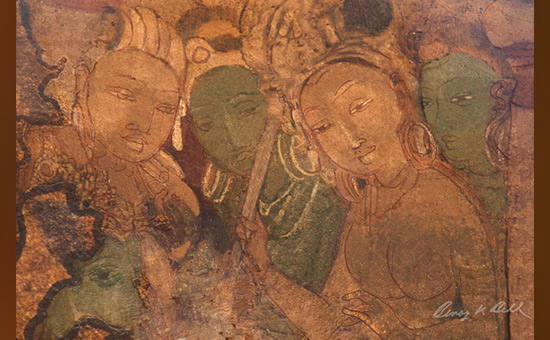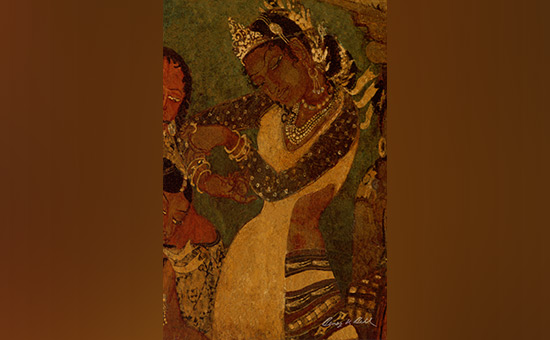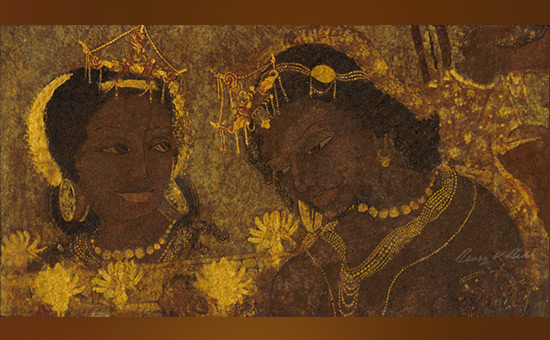Ajanta and the ancient murals of India display a
quality of art which is sublime and unexpected in paintings of that age. As you may be kindly aware, over
the past many years, my photographic documentation and international lectures
have established the continuous tradition of painting in ancient India, before
the world.
Revealing the Original
Beauty of Ancient Art
The centuries have taken their toll and the resplendent beauty of the
paintings has been obscured by damage.
Over a period of many years, as a labour of love, I have digitally restored much of the damage of
the masterpiece paintings. They can now be seen in their true glory.
This restoration has been meticulously and painstakingly done. It has
the advantage of my loving attention to these paintings over many years.
Digital software is a necessary tool to make such restoration possible.
However, this has been a painstaking exercise, incorporating deep art
historical understanding of the paintings, their grace and aesthetics.
Revealed! Earliest
Surviving Painting of the Hindu Tradition
Please see below which has been revealed through my photography in 2001 and my subsequent careful digital restoration. This is a ‘Queen and Attendants’ in Cave 3, Badami, 6th century CE. (see picture below).
Descriptions
of the Badami paintings in the 1950s included much painting which was lost by
the time I reached there to photograph in 2001. National Geographic Magazine,
when they were doing a major story about my work in 2008, could hardly see even
those paintings which I had seen and photographed in 2001. Therefore, this
photography and restoration is of fundamental importance in the documentation
of the tradition of Hindu paintings and in the overall tradition of the
paintings of India.
Ancient Murals of India
Over the
past many years, with careful art historical knowledge, I have restored many of
the masterpiece paintings of Ajanta, as well as other ancient murals of India,
which I am well-known to have documented. These have established the beautiful
and continuous tradition of painting in ancient and medieval India. As the
paintings are considerably damaged, the digital restoration has made it much
easier for the people to appreciate this early art.
Virtual Museums
The
Government has a vision of the vast documentation and digital restoration of
Indian art, as well as the making of Virtual Museums to take this art to the
people.
For this
purpose, Government Advisory Company Sapio Analytics have been taking shared
rights from me of some of my Ajanta photographs, as well as Badami and other
early Indian paintings. Sapio Analytics will be using these photographs and my
digital restoration for the Virtual Museums. They will also be using my digital
restoration for training purposes, to establish a base for future digital
restoration.
It is a
great pleasure for me to participate in this project of creating awareness of
the great art of India. It is also very fortunate that the deep art historical
understanding which I have formed over the past 44 years, is being used for
training and guidance.
One of my
world-acclaimed photographs of Ajanta was archived forever on October 21, in
the Arctic World Archives. Government Advisory Company Sapio Analytics had
taken from me the shared rights of the photograph to be archived.
 Queen & Attendants, Earliest-Surviving Hindu Painting, Cave 3, Badami, 6th century CE.
Queen & Attendants, Earliest-Surviving Hindu Painting, Cave 3, Badami, 6th century CE.
Descriptions of the Badami paintings in the 1950s included much painting which was lost by the time Behl reached there to photograph in 2001. National Geographic Magazine, when they were doing a major story about Behl’s work in 2008, could hardly see even those paintings which Behl had seen and photographed in 2001. Therefore, this photography and restoration is of fundamental importance in the documentation of the tradition of Hindu paintings. Photographed (2001) & Digitally Restored by Benoy K Behl.
 Dancing Girl, Cave 1, Ajanta, c. 5th century CE.
Dancing Girl, Cave 1, Ajanta, c. 5th century CE.
This is from a scene of the
Mahajanaka Jataka. Queen Shivali, wife of Bodhisattva King Mahajanaka, had
arranged for this dance performance before the King. The King had decided to
renounce his palace life and worldly possessions, to go into the forest as an
ascetic. The dance is arranged to try to distract the King and dissuade him
from doing so. Photographed (1992)
& Digitally Restored by Benoy K Behl.
 Dark Princess, Cave 1, Ajanta, 5th century CE.
Dark Princess, Cave 1, Ajanta, 5th century CE.
This is the consort of the Bodhisattva Vajrapani, painted in cave 1. In the 1920s, there was much comment about her beauty by British art historians and she was called the ‘Dark Princess’. Behl’s path-breaking photography and careful digital restoration has preserved her beauty for the world to admire. Behl has also used the reference of painted reproductions of this mural, which were made more than a hundred years ago. Photographed (1992) & Digitally Restored by Benoy K Behl.
To read all articles
by author